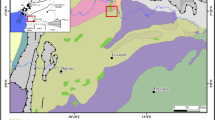Abstract
Zarshuran deposit is the most famous and important As-Au mine in Iran. However, there is no information on the impact of mining activity on the surrounding environment, especially on water systems. This paper attempts to document the concentration of arsenic and associated elements in waters and sediments resulting from the mining history of Zarshuran, a period covering hundreds of years. Water and sediment samples collected from Zarshuran Stream indicate high content of some potentially toxic elements, especially of As which ranges from 0.028 to 40 ng/l in water and 182 to 36,000 mg/kg in sediment samples. Mining activity, exposure of a large volume of mining wastes to weathering, and the anomalously high background of trace metals in the mining area are considered to be the main sources of heavy metal pollution.







Similar content being viewed by others
References
Asadi HH (2000) The Zarshuran gold deposit model applied in a mineral exploration GIS in Iran. PhD dissertation, University of Delft and ITC, The Netherlands
Asadi HH, Voncken JHL, Kuhnel RA, Hale, M (2000) Petrography, mineralogy and geochemistry of the Zarshuran Carlin-like gold deposit. Mineralium Deposita 35:672–682
Baba A, Güngör T (2002) Influence of gold mine on groundwater quality (Efemcukuru, Izmir, Turkey). Environ Geol 41:621–627
Banwart SA, Malmström ME (2001) Hydrochemical modelling for preliminary assessment of minewater pollution. J Geochem Explor 74:73–97
Bariand P (1962) Contribution a la mineralogie de l’Iran. Ph.D Thesis, Universite de Paris, Faculte des Sciences, Ser. A. No. 980
Bariand P, Cesborn F, Agrinier H, Geffroy J, Issakhanian V (1968) La Getchellite, AsSbS3, de Zarshuran, Afshar, Iran. Bull Soc Fr Mineral Crystallographie 95:403–406
Caboi R, Cidu R, Fanfani L, Lattanzi P, Zuddas P (1999) Environmental mineralogy and Geochemistry of abandoned Pb-Zn Montevecchio-Ingurtosu mining district, Sardinia, Italy. Chron Rech Minière 534:21–28
Ficklin WH, Plumlee GS, Smith KS, McHugh JB (1992) Geochemical classification of mine drainages and natural drainages in mineralized areas. In: Kharaka YK, Maest AS (eds) Water-rock interaction. Balkema, Rotterdam, 7, pp 381–384
Filella M, Belzile N, Chen YW (2002a) Antimony in the environment: a review focused on natural waters. I. Occurrence. Earth Science Reviews 57:125–176
Filella M, Belzile N, Chen YW (2002b) Antimony in the environment: a review focused on natural waters. II. Relevant solution chemistry. Earth Sci Rev 59:265–285
Gray JE, Crock JG, Fey DL (2002) Environmental geochemistry of abandoned mercury mines in West-Central Nevada, USA. Appl Geochem 17:1069–1079
Hopenhayn-Rich C, Biggs ML, Smith AH (1998) Lung and kidney cancer mortality associated with arsenic in drinking water in Cordoba, Argentina. Int J Epidemiology 27:561–569
Islam MDR, Salminen R, Lahermo PW (2000) Arsenic and other toxic elemental concentration of groundwater, surface water and soil in Bangladesh and its possible effects on human health. Environ Geochem Health 22:33–53
Karimi M (1993) The study of petrology, mineralogy, and genesis of Au-As Zarshuran Deposit, Takab. M.S. Thesis, Tarbiat Mo’alem University, Tehran, Iran (in Farsi)
Kazantzis G (2000) Thallium in the environment and health effects. Environ Geochem Health 22:275–280
Klein C, Hurlbut KS (1999) Manual of mineralogy, 21st edn. Wiley, New York
Lottermoser BG, Ashley PM, Lawie DC (1999) Environmental geochemistry of the Gulf Creek copper mine area, North-Eastern New South Wales, Australia. Environ Geol 39:67–74
Mehrabi B (1997) Genesis of the Zarshuran gold deposit, NW Iran. PhD Thesis, University of Leeds, UK (unpublished)
Milu V, Leroy JL, Peiffert C (2002) Water contamination downstream from a copper mine in the Apuseni Mountains, Romania. Environ Geol 42:773–782
Mohajer G, Parsaei H, Fallah N, Ma’dani F (1989) Mercury exploration in the Saein Dezh-Takab area. Tehran, Ministry of Mines and Metals of Iran (in Persian)
Munroe EA, McLemore VT, Kyle P (1999) Waste rock pile characterization, heterogeneity, and geochemical anomalies in the Hillsboro Mining District, Sierra County, New Mexico. J Geochem Explor 67:391–405
Ogola JS, Mitullah WV, Omula MA (2002) Impact of gold mining on the environment and human health: a case study in the Migori Gold Belt, Kenya. Environ Geochem Health 24:141–158
Smedley PL, Kinniburgh DG (2002) A Review of the source, behavior and distribution of arsenic in natural waters. Appl Geochem 17:517–568
Smith IC, Carson BL (1977) Trace metals in the environment. Ann Arbor Science, Michigan
Smith AH, Lingas EO, Rahman R (2000) Contamination of drinking water by arsenic in Bangladesh: a public health emergency. Bulletin of the World Health Organization 78(9):1093–1103
WHO (1993) Guidelines for Drinking Water Quality: Vol. 2. World Health Organization, Geneva
Acknowledgments
The authors would like to thank Dr M. Edraki of the Centre for Mined Land Rehabilitation, Queensland University, Australia, for critically reading the manuscript, and an anonymous reviewer for constructive remarks. Thanks are also due to the Department of Earth Sciences, Shiraz University for providing the means for this research.
Author information
Authors and Affiliations
Corresponding author
Rights and permissions
About this article
Cite this article
Modabberi, S., Moore, F. Environmental geochemistry of Zarshuran Au-As deposit, NW Iran. Env Geol 46, 796–807 (2004). https://doi.org/10.1007/s00254-004-1065-5
Received:
Accepted:
Published:
Issue Date:
DOI: https://doi.org/10.1007/s00254-004-1065-5




